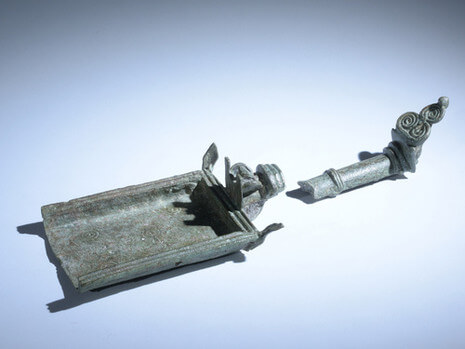According to Dina Avshalom Gurni, the director of the excavation on behalf of the Antiquities Authority: "The mochata we found, from the 2nd century AD, joins only about 10 mochata known in Israel from the Second Temple period.

A decorated chalice (a vessel for handling incense and coals and transferring them from one place to another) and a urn made of bronze were recently uncovered in archaeological excavations by the Antiquities Authority at a site intended for the construction of a hotel on Migdal Beach near the Sea of Galilee, owned by Arc New Gate Company.
The mat is considered a "servant vessel" that has sanctity in the work of the temple. It was used by the priests, and its main function was to move the incense and coals from place to place in the ceremony at the altar of incense. The name "machta" comes from the act of heating the coals - increasing the heat of the coals by moving and shaking them, and it is mentioned in the book of Exodus chapter XNUMX: (verses XNUMX-XNUMX): "And you made the altar... and you made its boats, its dung, and its basins and its fountains, and its forks Yu and his daughters-in-law ; For all his vessels, you shall make copper." In Jewish art, the appearance of the torch is common as part of the temple utensils, alongside the menorah, the lulav and the etrog.
According to Dina Avshalom Gurni, the director of the excavation on behalf of the Antiquities Authority: "The mochata we found, from the 2nd century AD, joins only about 10 mochata known in Israel from the Second Temple period. At the beginning of the research, it was believed that the heather was only used as a ritual tool for handling coals and incense that were used in ritual ceremonies. Over the years, after censers were also found without a ritual context, it seems that the censer was also used as a tool in everyday work. The kettle and the urn that were uncovered in the excavation were placed, one next to the other, on a stone floor inside one of the warehouses next to Migdal's pier. It is possible that these tools were kept as valuable for a family from the Jewish community of Migdal and stored there, or they may have been used on a daily basis.
In extensive excavations by the Antiquities Authority at the site in recent years, under the direction of Dina Avshalom Gurani and Arfan Najjar together with Marcela Septa from the University of Mexico, a Jewish settlement from the Second Temple period was uncovered in Migdal. A synagogue whose walls were decorated with colorful plaster. In the center of the reading room, a square stone was found, simulating the Temple in Jerusalem, and on one side of the stone is a seven-branched menorah decoration. The synagogue dates back to the 1st century AD - in the days when the Temple was active in Jerusalem, and is the seventh from this period known in Israel so far.
The current excavation season is focused on a warehouse structure near the pier of the large Jewish settlement of Migdal. Volunteers from Chile, Spain, Italy and Germany participated in the excavation, who came to Israel specifically to take part in the excavation.
According to Iyad Basharat, an archaeologist at the Antiquities Authority, "the excitement of the volunteers was very great. They were not relieved that these tools had been waiting just below the surface for 2000 years. Even we - seasoned diggers, were very excited: it's not every day that such rare finds are discovered, and in such a good state of preservation."
According to Arfan Najjar, the director of the excavation on behalf of the Antiquities Authority, "in the treasure from the days of the Bar Kochba revolt that Yigal Yedin found in the Toll Cave in the Judean Desert, a Mocha and Pech similar to those we found in the tower were found. In the Galilee, firecrackers were also found in Beit Tsida, Tayba, and Wadi Hamm, all in all, this is a rare find in the Galilee and the country in general."
Migdal (with its Greek name "Trichai", which means "the place for salting the fish" - something that suggests the main source of livelihood of the city's residents 2000 years ago, was a large Jewish settlement in the early Roman period. It is mentioned in Jewish sources, and in the document on the destruction of the Second Temple it served as its main base of Yosef ben Matthew
in his war with the Romans in Galilee. Evidence of a tower also exists in Christian sources, since according to tradition
Christian, it was the birthplace of Mary Magdalene, who was a central supporter of Jesus and was known as "the messenger of the apostles". According to the Gospels, Miriam was one of the women present at Jesus' crucifixion and resurrection.
The site is located near the settlement of Migdal in the north of the Sea of Galilee, it is open to visitors and offers a tour of the remains of the 2000-year-old settlement that was uncovered this year in excavations.
